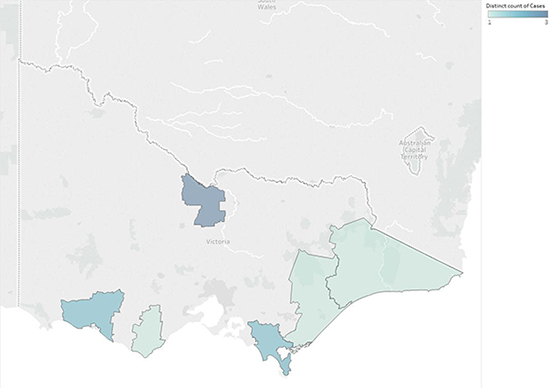Upper alimentary ulcerative syndrome research project update
In October 2016, Agriculture Victoria commenced a research project evaluating the prevalence of and risk factors for upper alimentary ulcerative syndrome (UAUS), with information packs and consumables forwarded to district veterinary officers around the state for distribution to private dairy practitioners in their districts.
To date, there have been investigations submitted to AgriBio from 10 properties with weaned calves meeting the case definition. The 10 cases across Victoria were found in the following shires:
- Campaspe Shire Council – 3 cases
- South Gippsland – 2 cases
- Moyne – 2 cases
- East Gippsland – 1 case
- Wellington – 1 case
- Colac Otway – 1 case
Figure 1 shows the location of properties submitted for the UAUS project (by shire), where colour intensity indicates the number of properties investigated.

Study herds have ranged in size from 130 to 650 cows, including Friesian, Jersey and crossbred calves. Samples have been submitted from a total of 103 animals, including clinical and non-clinical animals, with post-mortem sampling performed on 10 calves. The sampled calves ranged in age from 2 to 8 months with an average age of 4.5 months.
Diagnostic testing has included culture for Salmonella species and Yersinia, evidence of parasites, bovine viral diarrhoea virus (BVDV), parapox virus and bovine herpes virus. Calves from 5 herds were also tested for copper, vitamin B12 and selenium levels.
To date, only 1 of the 10 herds has been identified with lesions suggestive of UAUS.
The following table summarises the laboratory results collated so far.
Table 1. Summary of laboratory results for the UAUS Research Project
| Pathogen | Number of herds with test positive calves |
|---|---|
Bovine herpes virus | 0 |
BVDV | 1 |
Salmonella sp | 1 |
Yersinia sp | 4 (Yersinia was also cultured from non-clinical animals in several herds) |
Parapox virus | 3 |
Coccidia oocysts | 2 |
Feacal egg counts | 2 |
As, based on historical cases, the peak timing for UAUS in Victorian dairy calves appears to be between October and March, further new cases may present this month.
Final results for this season of the project will be presented in the next edition of VetWatch. The research project will continue for a further 2 seasons and updates will be provided throughout that time.
More information about the case definition and what is involved in the project is available on the Upper alimentary ulcerative syndrome page.